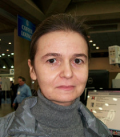Table of Contents
Definition / general | Clinical features | Treatment | Gross description | Microscopic (histologic) description | Positive stains | Negative stains | Differential diagnosisCite this page: Handra-Luca A. Squamous cell carcinoma. PathologyOutlines.com website. https://www.pathologyoutlines.com/topic/salivaryglandsSCC.html. Accessed March 31st, 2025.
Definition / general
- True salivary gland primaries of squamous cell carcinoma are very rare; most squamous cell carcinomas are metastases to intraparotid lymph nodes from primaries in oral cavity, upper aerodigestive tract or skin
- Squamous cell carcinomas represent 16 - 54% of malignant salivary gland tumors, about 11% of malignant tumors of major salivary glands
Clinical features
- Squamous cell carcinomas (primary or secondary) are most frequent parotid malignant tumor (30 - 37%), represent 4% of submandibular gland tumors
- Usually men (when considering major salivary gland tumors); also associated with AIDS
- May occur in Stensen duct
- Rapid painless growth with infiltration of surrounding structures, regardless of origin; may cause acute facial paralysis
- Aggressive behavior, with 50% 5 year survival (Arch Pathol Lab Med 2001;125:740)
Treatment
- Radical surgery, radiation therapy
Gross description
- Large, poorly encapsulated mass
Microscopic (histologic) description
- Classic features of squamous cell carcinoma
- May have perineural invasion, clear cell change
- Often component or coexisting with other tumors: carcinosarcoma, epidermoid cyst, epithelial myoepithelial carcinoma, malignant mixed tumor, mucoepidermoid carcinoma, sarcomatoid carcinoma, salivary duct carcinoma, sebaceous lymphadenoma, Warthin tumor (Mod Pathol 2002;15:724)
Positive stains
Negative stains
- CK20, COX2, CK8, factor XIIIa, p16, CDK4, Rb, E2F1
- Loss of E-cadherin
Differential diagnosis
- Adenoid cystic carcinoma: p63+, resembles basaloid squamous cell carcinoma (Mod Pathol 2005;18:645)
- High grade mucoepidermoid carcinoma: intermediate cells, mucus cells, COX2+




